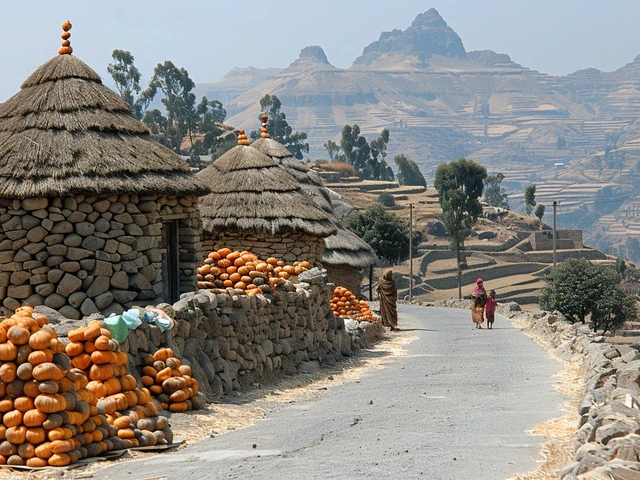Ethiopia, a country known for its rich history and diverse culture, has a complex economic landscape that affects the average monthly income of its citizens.
Despite significant strides in economic growth and development, the country still faces challenges that impact the financial well-being of its population.
This article dives into various aspects of income in Ethiopia, shedding light on how different factors contribute to the average monthly earnings, the role of key sectors, regional variances, and the ingenious ways locals tackle financial hurdles. Let's look closely at how Ethiopians navigate their economic reality.
- Overview of Ethiopia's Economy
- Income Distribution
- Key Economic Sectors
- Regional Differences
- Managing Financial Challenges
Overview of Ethiopia's Economy
Ethiopia, often noted for its vibrant history and beautiful landscapes, also has an economy that's both diverse and rapidly evolving. Over the last decade, the nation has experienced substantial economic growth, driven by a mix of agriculture, manufacturing, and services. Agriculture remains a cornerstone, employing about 70% of the workforce and contributing significantly to the GDP. Coffee, being one of the prominent exports, plays a vital role in both the economy and the culture.
The government has made considerable strides in improving infrastructure, focusing on roads, railways, and energy, which are critical to sustaining economic growth. The Grand Ethiopian Renaissance Dam (GERD), for example, is a transformative project aimed at providing a stable electric supply, essential for industrial growth. Despite these advancements, the economic landscape is not without challenges. Inflation rates have been a persistent issue, affecting purchasing power and cost of living. In recent years, Ethiopia has also seen efforts to privatize some state-owned enterprises, indicating a shift towards a more mixed economy.
The industrial sector, particularly textile and apparel manufacturing, has shown promising growth, attracting foreign investment. This sector not only creates jobs but also diversifies the nation's dependence on agriculture. Tech startups and innovation hubs are emerging, although they are still in the nascent stages compared to other sectors.
According to the World Bank, Ethiopia's GDP growth rate was around 9% before the global pandemic, but it slowed down slightly due to the economic disruptions caused by COVID-19. The pandemic brought many challenges but also showcased the resilience and adaptability of the Ethiopian economy. E-commerce and digital finance saw a spike as people adapted to new ways of living and conducting business during lockdowns.
As the World Bank noted, "Ethiopia has shown remarkable economic resilience, but continued reforms are essential to sustain its growth trajectory."
Poverty remains an area of concern despite the economic development. Many Ethiopians still live under the poverty line, primarily in rural areas. However, social programs aimed at improving education and healthcare are contributing toward alleviating poverty. The expansion of education has also created a more skilled workforce, which bodes well for future economic growth.
Ethiopian income is affected by various factors, including regional disparities and the nature of employment, with many people working in informal sectors. Urban areas like Addis Ababa offer more employment opportunities and higher wages compared to rural settings. Still, the cost of living in cities is relatively higher, balancing out the income differences to some extent.
Trade relations play a crucial role as well. Ethiopia's strategic location in the Horn of Africa makes it a significant player in regional trade. Agreements with neighboring countries and investments in improving port access are geared towards promoting export and import businesses.
As Ethiopia continues to navigate its path of development, the focus remains on sustainable growth. Policies directed at technological innovation, infrastructure improvement, and poverty alleviation are essential to propel the country further. The coming years will be telling as to how effectively these policies are implemented and the impact they will have on the average monthly income in Ethiopia.
Income Distribution
Income distribution in Ethiopia presents a vivid picture of the contrasts in prosperity and economic equity across different segments of the population. While the country's economy has been making significant progress, the benefits of this growth have not been evenly distributed.
One of the key aspects of the Ethiopian income landscape is that a large proportion of the population still relies on agriculture for their livelihood. This sector, although vital, often yields lower income levels compared to urban jobs. Farmers in rural areas sometimes earn just a fraction of what workers in urban centers make. Ethiopian income disparities are evident when we compare the average monthly salaries of those working in agriculture with those in sectors like technology, manufacturing, or services.
Interestingly, the informal sector in Ethiopia also plays a considerable role in income distribution. Many people engage in small trade, street vending, or artisanal activities to make a living. These jobs, although not formally recorded, provide an essential income source for thousands of families. However, the earnings in this sector can be highly variable and unstable.
Government and international organizations aim to address these disparities. The Ethiopian government has introduced various schemes and policies to boost rural incomes, improve agricultural productivity, and create more urban job opportunities. For instance, the Agricultural Transformation Agency (ATA) has been working on several programs to modernize farming techniques and improve yields. Additionally, efforts to expand the manufacturing sector through initiatives like the Growth and Transformation Plan (GTP) have shown promise in creating better-paying jobs in urban areas.
A 2021 World Bank report highlighted that despite these efforts, a significant proportion of the population still lives below the poverty line. The report stated, "Approximately 24% of Ethiopians live in extreme poverty, indicating a need for more inclusive economic growth." This underscores the necessity for continuous efforts to bridge the income gap and create a more equitable distribution of wealth.
Monthly salary disparities also exist within urban areas. Professionals in banking, telecommunications, and other advanced sectors often earn substantially more than those in service or retail jobs. For example, a study conducted by the Ethiopian Central Statistical Agency showed that the average monthly income for a software engineer in Addis Ababa can be several times higher than that of a retail worker or a domestic helper.
Education level is another significant factor influencing income distribution. Individuals with higher educational qualifications tend to secure better-paying jobs. Government efforts to improve access to education and the quality of schooling aim to level the playing field. Programs such as the Education Sector Development Program (ESDP) focus on both increasing enrollment rates and enhancing learning outcomes, potentially leading to more equitable income distribution in the future.
The role of remittances cannot be overlooked when discussing income distribution. Many Ethiopians receive financial support from relatives working abroad. These remittances can significantly boost the incomes of recipient households, providing them with better living standards and opportunities. The inflow of money from abroad adds an additional layer of complexity to the income distribution landscape.
To summarize, income distribution in Ethiopia is a multifaceted issue influenced by various factors, including economic sectors, geographic location, education levels, and external financial support. While the country has made commendable progress over the years, addressing the imbalances requires sustained and concerted efforts from both governmental and non-governmental entities.

Key Economic Sectors
Understanding Ethiopia's economy requires diving into its vital sectors that drive income generation. The backbone of the country's economy is agriculture, employing nearly 70% of the population and contributing approximately 40% to the GDP. The fertile lands of the Ethiopian Highlands are perfect for growing crops like coffee, teff, maize, and sorghum. Coffee is especially important, as it’s Ethiopia's most famous export, earning it the nickname 'the birthplace of coffee'. Many smallholder farmers rely on these crops not just for their livelihoods but also as a primary source of food for their households.
Though agriculture remains dominant, the industrial sector is gradually gaining momentum. Manufacturing, particularly in textiles and leather, is expanding due to foreign investments and supportive government policies. Ethiopia aims to become a light manufacturing hub in Africa. The construction boom, symbolized by urban development in Addis Ababa, also showcases significant industrial growth. Infrastructure projects like railways, roads, and housing developments have created numerous jobs and contributed to urban migration.
The service sector is another burgeoning area. With an annual growth rate higher than both agriculture and industry, it includes telecommunications, banking, tourism, and retail. The tech industry is showing promise, bolstered by young entrepreneurs and initiatives like startup incubators. Tourism has witnessed substantial growth, thanks to the country's rich cultural heritage and natural attractions like the Simien Mountains, Lalibela churches, and the Great Rift Valley.
According to a report by the Central Statistics Agency, Ethiopia's GDP grew by 6.1% in 2023, demonstrating resilience despite global economic challenges.
“Ethiopia's diversified economy is showing potential across multiple sectors,” says Dr. Eleni Gabre-Madhin, an eminent economist and founder of the Ethiopia Commodity Exchange.This diversified growth trajectory reflects a strategy to reduce dependency on agriculture by fostering industrial and service sectors.
However, challenges persist. Climate change affects agricultural productivity, and political uncertainties can hamper investment and business confidence. Still, with policies aimed at economic diversification and sustainable growth, Ethiopia is navigating these hurdles to improve the average monthly income across sectors. Focused interventions, such as enhancing agricultural techniques, fostering local industries, and building robust service-based businesses, are crucial steps.
For anyone interested in the average monthly income in Ethiopia, understanding these key economic sectors provides a well-rounded perspective. By appreciating the roles agriculture, industry, and services play, one can see how economic efforts are directed to improve livelihoods, create jobs, and sustain growth. Ethiopia's story is one of balancing traditional practices with modern ambitions to build an economically inclusive future.
Regional Differences
The average monthly income in Ethiopia varies greatly across its regions due to the country's diverse socioeconomic landscape. Addis Ababa, the nation's bustling capital, typically enjoys higher wages compared to rural areas. This is largely attributable to its status as the commercial hub, boasting a wealth of opportunities in sectors like banking, manufacturing, and services. It's not uncommon for professionals in Addis Ababa to earn salaries that are significantly above the national average.
Conversely, the income disparity becomes stark when you look at more remote areas such as the Afar and Somali regions. These areas often rely on agriculture and pastoralism, professions that unfortunately don't pay as much. The limited access to infrastructure and education also hinders income growth in these parts. An interesting fact is that while rural households may earn less in monetary terms, many rely on subsistence farming, which affects their need for cash income.
The Southern Nations, Nationalities, and People's Region (SNNPR), though relatively more prosperous than some northern and eastern regions, still faces challenges. Cash crops like coffee and enset (false banana) are predominant in this area, offering a moderate income source compared to the urban sectors in Addis Ababa. A noticeable trend in these areas is migration towards the capital city and other urban centers, seeking better employment opportunities.
Income and Education Correlation
The role of education in income disparity across regions cannot be underestimated. Regions with higher educational institutions tend to have a populace with better earning capabilities. Oromia and Amhara regions, home to some of the country's prominent universities, exhibit varied income levels. Graduates from these regions often move to urban centers to leverage their qualifications. Hence, accessibility to education is a crucial factor that drives the differences in income levels.
"Ethiopia’s regional income disparity is largely influenced by the availability of educational and economic opportunities, as well as access to essential infrastructure. Addressing these gaps is key to achieving balanced economic growth," says Mekonen Ayana, an economist at the Ethiopian Development Research Institute.
Efforts to bridge these gaps are ongoing. Government initiatives aim to uplift less developed regions by improving infrastructure, providing better healthcare, and expanding educational facilities. Projects like the Grand Ethiopian Renaissance Dam (GERD) are seen as beacons of hope for driving economic growth across the nation, impacting even the most remote areas.
Yet, the journey towards equitable income distribution is long. Understanding the intricacies of regional income differences is the first step towards implementing effective policies. As Ethiopia continues to develop, striking a balance will remain a central focus for policymakers aiming to enhance the quality of life for all its citizens.

Managing Financial Challenges
Living in Ethiopia comes with its set of financial hurdles. Despite a steady economic growth rate, many citizens often find themselves navigating a rocky financial landscape. With the average monthly income still relatively low, people have developed innovative and resourceful ways to make ends meet.
One common strategy is participation in local savings groups known as 'Equb'. These informal associations allow members to pool their money and take turns receiving the lump sum. This financial cooperative system has deeply ingrained itself in Ethiopian society, providing a safety net for many. By joining an Equb, members can undertake larger expenses like medical care, education, or even starting a small business.
Agriculture remains the backbone of Ethiopia's economy, employing a significant portion of the population. Farmers often face unpredictable weather conditions that can impact crop yields and, consequently, their income. To manage this uncertainty, some farmers have diversified their crops or ventured into livestock farming, which can provide a more stable income stream. Additionally, there are governmental and non-governmental programs that offer training and resources to help farmers improve their agricultural practices and productivity.
In urban areas, the gig economy is becoming increasingly prevalent. People take on various temporary or freelance jobs to supplement their primary income. Whether it's driving for ride-sharing services, offering tutoring, or running small-scale businesses, these gigs provide additional streams of income that can make a big difference. The rise of mobile technology has also made it easier for individuals to find and participate in these gig opportunities.
"In Ethiopia, the key to financial survival lies in community and diversification," says Sarah Tewolde, an economist specializing in East African economies. "People rely on their community networks and multiple income sources to navigate their financial challenges."
Another significant aspect is remittances from Ethiopians living abroad. Many families rely on the financial support sent by their relatives working in other countries. These remittances play a substantial role in alleviating financial pressures and improving the quality of life for those back home. According to World Bank data, remittances to Ethiopia reached $5 billion in 2023, highlighting their importance to the country's economy.
For the younger generation, education remains a powerful tool for upward mobility. Many young Ethiopians pursue higher education, often supported by scholarships or family savings, with the hope of securing better-paying jobs. Education not only opens doors to more lucrative career opportunities but also equips individuals with the skills needed to adapt and thrive in an ever-evolving job market.
There are also efforts from the government and non-governmental organizations to enhance financial literacy among the population. Workshops and training programs aim to teach people about budgeting, saving, and investing wisely. With better knowledge of financial management, individuals can make more informed decisions that positively impact their economic well-being.
Despite the challenges, Ethiopians display remarkable resilience and adaptability in their financial lives. Whether through community support systems, agricultural diversification, gig work, remittances, education, or improved financial literacy, the people of Ethiopia find ways to manage their economic reality and build a better future for themselves and their families.

 Starting a Small Business in Ethiopia: Key Steps and Insights
Starting a Small Business in Ethiopia: Key Steps and Insights
 Navigating Business Risks in Ethiopia: Opportunities and Challenges
Navigating Business Risks in Ethiopia: Opportunities and Challenges
 Discovering Ethiopia's Wealthiest: A Look at the Richest Person
Discovering Ethiopia's Wealthiest: A Look at the Richest Person
 Top Trending Careers in Ethiopia: A 2024 Insight
Top Trending Careers in Ethiopia: A 2024 Insight
 Understanding Poverty in Ethiopia: Facts and Insights
Understanding Poverty in Ethiopia: Facts and Insights
christine mae cotejo
September 10, 2024 AT 17:44The average monthly income figures you presented are just the tip of a far more intricate socioeconomic iceberg. While the macro‑level GDP growth looks impressive, it masks stark regional inequities that hit farmers hardest. In the highlands especially, smallholder coffee growers often earn merely enough to purchase next season's inputs, forcing many into a perpetual cash‑flow crunch. Moreover, the informal savings circles known locally as “Equb” act as a crucial buffer for those households, enabling lump‑sum expenditures such as school fees or medical emergencies that salaries alone cannot cover. These Equb groups operate on trust and rotate a pooled fund, effectively providing interest‑free credit that formal banks seldom extend to low‑income borrowers. Unfortunately, the lack of regulatory oversight also means that members can suffer loss if the organizer disappears, a risk that is rarely quantified in national statistics. Another layer worth noting is the gender wage gap; women in agriculture earn on average 20 % less than men, a disparity amplified by limited access to land titles and credit. The government’s push for industrial parks, particularly in the textile sector, has indeed generated new wage‑earning opportunities, yet many of those jobs are contract‑based, offering limited benefits and job security. Urban migration further strains the labor market in Addis Ababa, driving down wages for low‑skill workers as supply outstrips demand. On the flip side, remittances from the diaspora have become a lifeline for rural families, injecting hard currency that can elevate household income by up to 30 % in some regions. However, reliance on external money flows also creates vulnerability to global economic shocks, as we observed during the pandemic‑induced downturn. Financial literacy programs, some run by NGOs, are beginning to teach budgeting and modest investment strategies, which could slowly lift incomes over the next decade. It is also essential to recognize the role of education; secondary school completion rates have risen, but the quality of schooling remains uneven, limiting the translation of diplomas into higher earnings. Climate variability continues to threaten crop yields, prompting a gradual shift toward drought‑resistant varieties and diversified farming, which can stabilize incomes if supported by proper extension services. In sum, the average monthly income statistic is a mosaic of agriculture, informal finance, regional policy, gender dynamics, and global remittances, all interacting in ways that demand nuanced, locally‑tailored interventions rather than one‑size‑fits‑all solutions.
Douglas Gnesda
September 12, 2024 AT 18:37Delving into the sectoral breakdown, it's evident that agriculture still anchors about 40 % of Ethiopia's GDP, yet its productivity metrics lag behind global benchmarks. The manufacturing surge, particularly in textile and apparel clusters, has introduced a modest wage premium, but the skill mismatch persists, throttling potential gains. Service industries-telecommunications, fintech, and tourism-are expanding at a compound annual growth rate exceeding 12 %, injecting higher‑value jobs into urban centers. Fiscal policy reforms, such as the recent tax incentives for foreign direct investment, are designed to catalyze this transition, though implementation bottlenecks remain. Meanwhile, the inflation trajectory, which hovered around 15 % last year, erodes real earnings, especially for low‑income households. Infrastructure projects like the GERD and new rail corridors are expected to reduce logistics costs, thereby improving profit margins across sectors. In practice, however, the multiplier effect on average monthly income will depend on how swiftly these macro‑level initiatives permeate down to the grassroots level.
Abhijit Pimpale
September 14, 2024 AT 19:30The data you cite about the GERD's impact on industrial growth lacks recent verification.
Eric DE FONDAUMIERE
September 16, 2024 AT 20:24Yo, the article really hits the nail on the head about Ethiopia's hustle.
But dude, the whole part on "tech startups are in nascent stages" could use some more concrete exampels.
Also, i think they forgot to mention the recent mobile money boom that is changin how people pay bills.
Overall, good job but needs a bit more up‑to‑date stats.
Pauline Herrin
September 18, 2024 AT 21:17While the overview is comprehensive, several assertions warrant further scrutiny. The claim that 70 % of the workforce remains in agriculture appears to rely on outdated census data from 2015, ignoring recent urbanization trends. Moreover, the discussion of inflation does not differentiate between headline CPI and food‑price specific indices, which have divergent impacts on household purchasing power. The reference to the Grand Ethiopian Renaissance Dam as a catalyst for industrial growth lacks an analysis of its current operational capacity and the attendant energy distribution challenges. Lastly, the treatment of regional income disparities would benefit from granular sub‑regional statistics rather than broad generalizations. A more nuanced evidentiary base would strengthen the overall argument.
pradeep kumar
September 20, 2024 AT 22:10The piece overlooks the informal sector's volatility, which is a major income driver.
Without addressing that, the analysis feels incomplete.
love monster
September 22, 2024 AT 23:04Great synthesis! I’d add that the rapid rollout of 4G networks has actually lowered transaction costs for small merchants, amplifying the service sector’s reach into peri‑urban zones. This digital diffusion, paired with mobile micro‑financing, creates a feedback loop that can gradually uplift average earnings beyond what raw sectoral GDP numbers suggest.
Christian Barthelt
September 24, 2024 AT 23:57Interesting take, but I think you overstate the protective role of Equb groups; in many cases they simply mask deeper financial fragility rather than solve it. The reliance on informal credit can entrench borrowers in cycles of debt, especially when repayment expectations become unsustainable. So, while they’re culturally significant, their economic efficacy remains debatable.
Ify Okocha
September 27, 2024 AT 00:50The article reads like a glossy press release, ignoring the hard‑core reality that most Ethiopian households survive on subsistence farming and receive negligible cash flow. Any mention of “growth” feels like wishful thinking when poverty rates stubbornly hover around a quarter of the population. The narrative glosses over systemic corruption that siphons resources away from genuine development projects.
William Anderson
September 29, 2024 AT 01:44Honestly, this piece is a masterpiece of academic fluff-words for words’ sake, no substance. It drifts through buzzwords like “resilience” and “innovation” while the lived experience tells a far bleaker story. A little more grit and less glitter would have done wonders.
Sherri Gassaway
October 1, 2024 AT 02:37One might ponder whether the metric of “average monthly income” truly captures the essence of prosperity. After all, wealth can be woven into communal bonds, shared harvests, and the intangible wealth of cultural heritage. If we reduce existence to a solitary figure, perhaps we lose sight of the richer tapestry that defines humanity.
Milo Cado
October 3, 2024 AT 03:30Thank you for the meticulous critique; it sharpens the conversation. Incorporating the latest labor force survey data will indeed provide a clearer picture of urban migration trends. Additionally, differentiating between headline and food inflation could illuminate the nuanced pressures households face. Looking forward to seeing these refinements in future updates! 😊
MONA RAMIDI
October 5, 2024 AT 04:24Stop sugar‑coating the situation-people are still stuck in cash‑strapped cycles, and your optimistic tone does them no favors.
grace riehman
October 7, 2024 AT 05:17hey folks, just wanted to point out that many local NGOs run youth training progams that actually teach people how to manage money and even start small biz. these kinda grassroots efforts are super important, even if they don't make the headlines.
Vinay Upadhyay
October 9, 2024 AT 06:10Oh wow, a digital revolution powered by 4G? Yeah, because nothing says “economic uplift” like buffering videos on a shaky connection while you wait for your cash to clear.
Eve Alice Malik
October 11, 2024 AT 07:04i'm curious how remittance inflows compare between the northern and southern regions-any data on that would be super helpful.